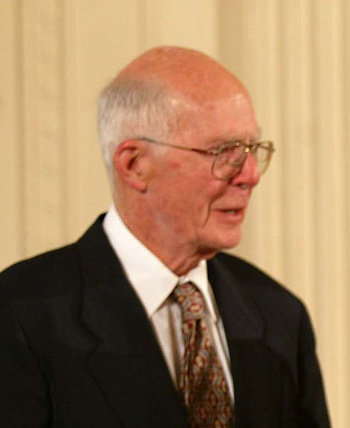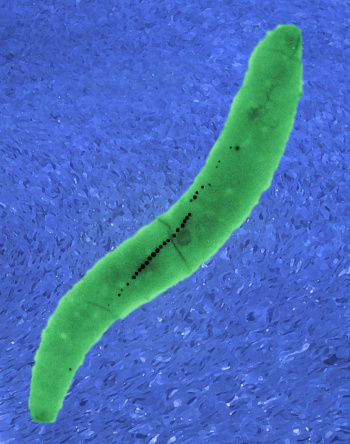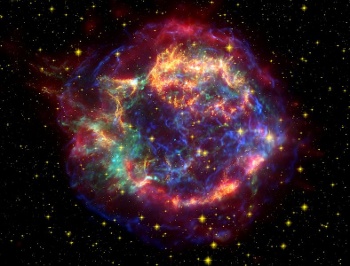Bacterial Iron Isotopes
July 22, 2013
Our knowledge of the existence of
atoms is not that old.
Democritus named the atom (α-τομ, "not cutable") about 450 BC, but his arguments about its existence were
philosophical, not
scientific. The scientific basis of atomism only occurred in 1805, when the
chemist,
John Dalton, presented
experiments with a matching
atomic theory.
Dalton's work didn't address the
size of atoms. That was left to the
Austrian physical chemist,
Johann Josef Loschmidt. Loschmidt determined the probable size of "
air molecules," and he obtained a
constant, now called
Loschmidt's number, which is the number of molecules of an
ideal gas in a given
volume; that is, its
number density.
This huge number has an established modern value of 2.6868 x10
25 per cubic meter at
standard temperature and pressure (STP, 273.15 K (0 °C) and 100
kPa (0.986
atm)). Considering how large that large number is, imagine the audacity of trying to get
funding for an experiment in which you intend to count individual atoms. That's somewhat more practical in this age of
nanotechnology, but
physicist,
Raymond Davis, Jr., proposed this in the
1960s. Not only that, but his experiment was operated almost a
mile underground in a
gold mine.[1]
His
Homestake experiment, located in the
Homestake Mine in
Lead, South Dakota, was designed to detect
solar neutrinos.[1-2] In 1939,
Hans Bethe published the
supposed nuclear reactions that power the
Sun, and these produce an abundance of
electron neutrinos. Since these neutrinos had never been detected, Davis decided to give it a try.
One trouble with neutrinos is that they don't interact very often with other
particles. The
neutrino detector devised by Davis was a tank filled with 100,000
gallons of the common
dry-cleaning chemical,
tetrachloroethylene. This was a convenient source of
chlorine, and a chlorine
nucleus (
atomic number 17) will transmute to an
argon nucleus (atomic number 18) when hit by a neutrino. An elaborate system was devised to extract these argon atoms from the tank.[1-2]
John Bahcall had calculated that there would only be about five argon atoms generated per day. Less than two argon atoms were found each day.[2]
Statistics showed that the measured neutrino flux was
one-third of what was calculated. Neither the measurement nor the calculation was wrong. Davis had discovered
neutrino "flavor" oscillations, since his detector responded to just one of three types of neutrinos. For this work, Davis shared the 2002
Nobel Prize in Physics.

Raymond Davis, Jr. (October 14, 1914 - May 31, 2006)
Davis was lucky to have lived to a reasonable old age, since his neutrino experiment needed extensive corroboration.
After that, the 2000 Wolf Prize in Physics, the 2001 National Medal of Science, and the 2002 Nobel Prize in Physics came in quick succession.
(2001 National Science Foundation photograph, via Wikimedia Commons.)
Preliminary data on a similar atom counting feat has just been shared by
Shawn Bishop, a physicist from the
Technische Universität München, who reported on the work of a
German-
Austrian team looking for traces of the
iron isotope,
Fe-60, on the
Earth.[4-8] This isotope has a
half-life of 2.62
million years, so none of it would remain from the
formation of the Earth. This iron isotope, however, is created in
supernovas, so a nearby supernova could have deposited some of the isotope on Earth in the recent past. The problem, however, is how to find it.
The tactic used by this
research team is to mine iron that was concentrated by ancient
oceanic bacteria and deposited onto the
seabed at their demise. As I wrote in a
previous article (Magnetic Yeast, March 7, 2012), some
animals, including some bacteria,[9-10] possess
receptors for
magnetic field, a property known as
magnetoception. These receptors contain the iron-bearing mineral,
magnetite, Fe
3O
4, as crystals about 80
nanometers in
diameter.

TEM image of Magnetospirillum gryphiswaldense(MSR-1), a freshwater Gram-negative microaerophilic bacterium.
The bacteria synthesize magnetite (Fe3O4) nanoparticles that are arranged in a chain inside the cell allowing the organism to orient itself in Earth's geomagnetic field.
(Photograph by Zachery Oestreicher and Brian H. Lower. Used with permission.)
The first detection of
environmental Fe-60 came in 2004 with its discovery in a
ferromanganese crust from the floor of the
equatorial Pacific Ocean. The specimen was dated to be about 2.2 million years old, so the originating supernova would have been near that time, which is about the time that modern
humans appeared.[5,7] The originating supernova was likely the one discovered as a
remnant in the
Scorpius–Centaurus star cluster.[6] In general, supernovas are bad for your health, since they also emit copious
gamma radiation. Bishop, as quoted in
APS News, said, "That we're here talking about it indicates that the supernova wasn't too close."[6]
As the Earth passed through the supernova's debris cloud, bacteria would have incorporated that iron isotope, dissolved into ocean water from atmospheric dust, into their magnetite crystals.[5-6] The German-Austrian team analyzed a portion of a core specimen obtained during the
Pacific Ocean Drilling Program. They took samples at 100,000 year intervals in its span of 1.7-3.3 million years ago.[5,7]

A false color image of supernova remnant, Cassiopeia A, formed from Hubble telescope, Spitzer telescope and Chandra X-ray Observatory images.
(NASA/JPL-Caltech image, via Wikimedia Commons.)
The iron was extracted by a
chemical technique that selected just the iron from biological sources. Forty
grams of sediment produced just three
milligrams of iron, of which just one part in 10
15 is Fe-60. The team analyzed for Fe-60 by radiating it with a
cesium ion beam in an
accelerator at the
Maier-Leibnitz-Laboratory near
Munich. The cesium, bound to iron, was counted at a
particle counter.[6] Said Bishop in APS News, "We're literally counting individual atoms of iron-60 that come out of the sample material."[6]
Cautioning that the data are preliminary and their technique has not passed
peer review, Bishop reported at the
Denver, Colorado, meeting of the
American Physical Society that the Fe-60 peaks at about 2.2 million years ago, at the purported time of the Scorpius–Centaurus supernova about 424
light years from the Sun.[4,7] The research team is now analyzing a second core specimen to verify the Fe-60 signal.[6-7]
It's interesting to note that I once
grew a
crystal, isotopically-enriched with another isotope of iron,
iron-57, for a
nuclear physics experiment.[11]
References:
- Raymond Davis Jr. - Solar Neutrino Experiments, Brookhaven National Laboratory Web Site.
- Solar Neutrinos Are Counted at Brookhaven, Bulletin Board, vol. 21, no. 36 (September 14, 1967), Brookhaven National Laboratory Public Relations Office (PDF File).
- H. A. Bethe, "Energy Production in Stars," Physical Review, vol. 55, no. 5 (March, 1939), p. 434-456.
- Shawn Bishop, Peter Ludwig, Ramon Egli, Valentina Chernenko, Thomas Frederichs, Silke Merchel and Georg Rugel, " Search for Supernova 60Fe in the Earth's Fossil Record," Paper BAPS.2013.APR.X8.2 of the APS April Meeting 2013, Meeting Abstracts, vol. 58, no. 4 (2013).
- Researchers find hints of supernova iron in bacteria microfossils: First biological evidence of a supernova, Technische Universität München Press Release, May 8, 2013.
- Michael Lucibella, "Supernova Data Hide in Ancient Bacterial Remains, APS News, Series II, vol. 22, no. 6 (June 2013), p. 5.
- Alexandra Witze, "Supernova left its mark in ancient bacteria," Nature News, April 15, 2013, DOI: 10.1038/nature.2013.12797.
- Shawn Bishop and Ramon Egli, "Discovery Prospects for a Supernova Signature of Biogenic Origin," arXiv Preprint Server, March 28, 2011.
- Richard Blakemore, "Magnetotactic Bacteria". Science, vol. 190, no. 4212 (October 24, 1975), pp. 377-379.
- Richard P. Blakemore, Magnetotactic Bacteria, Ann. Rev. Microbiol, vol. 36 (1982), pp. 217-238 (PDF File).
- D.M. Gualtieri, W. Lavender and S. Ruby, "57Fe-YIG: Narrow Xray Linewidth Epitaxial Layers on Gd3Ga5O12," J. Appl. Phys., vol. 63, no. 8 (April 15, 1988), pp. 3795-3797.
Permanent Link to this article
Linked Keywords: Atom; Democritus; philosophy; philosophical; science; scientific; chemist; John Dalton; experiment; atomic theory; atomic radius; size of atoms; Austria; Austrian; physical chemistry; physical chemist; Johann Josef Loschmidt; atmosphere of Earth; air; molecule; physical constant; Loschmidt's number; ideal gas; volume; number density; standard temperature and pressure; STP; kPa; atmosphere; atm; funding of science; nanotechnology; physicist; Raymond Davis, Jr.; 1960s; mile; gold mine; Homestake experiment; Homestake Mine; Lead, South Dakota; solar neutrino; Hans Bethe; stellar nucleosynthesis; nuclear reaction; Sun; electron neutrino; elementary particle; neutrino detector; gallon; dry-cleaning; chemical; tetrachloroethylene; chlorine; nucleus; atomic number; argon; John Bahcall; statistics; solar neutrino problem; neutrino oscillation; neutrino "flavor" oscillation; Nobel Prize in Physics; reproducibility; Wolf Prize in Physics; National Medal of Science; Wikimedia Commons; Shawn Bishop; Technical University Munich; Technische Universität München; Germany; Austria; iron; isotope; Fe-60; Earth; half-life; Myr; million years; formation of the Earth; supernova; research; oceanic; bacteria; seabed; animal; receptor; magnetic field; magnetoception; magnetite; nanometer; diameter; transmission electron microscopy; TEM; gram-negative; microaerophilic; nanoparticle; Zachery Oestreicher; Brian H. Lower; environmental; ferromanganese; equatorial; Pacific Ocean; human; supernova remnant; Scorpius–Centaurus star cluster; gamma radiation; APS News; Integrated Ocean Drilling Program; Pacific Ocean Drilling Program; Cassiopeia A; Hubble Space Telescope; Spitzer Space Telescope; Chandra X-ray Observatory; chemical reaction; gram; milligram; cesium; ion beam; accelerator mass spectrometry; Maier-Leibnitz-Laboratory; Munich; particle counter; peer review; Denver, Colorado; American Physical Society; light year; crystal growth; crysta; iron-57; nuclear physics.